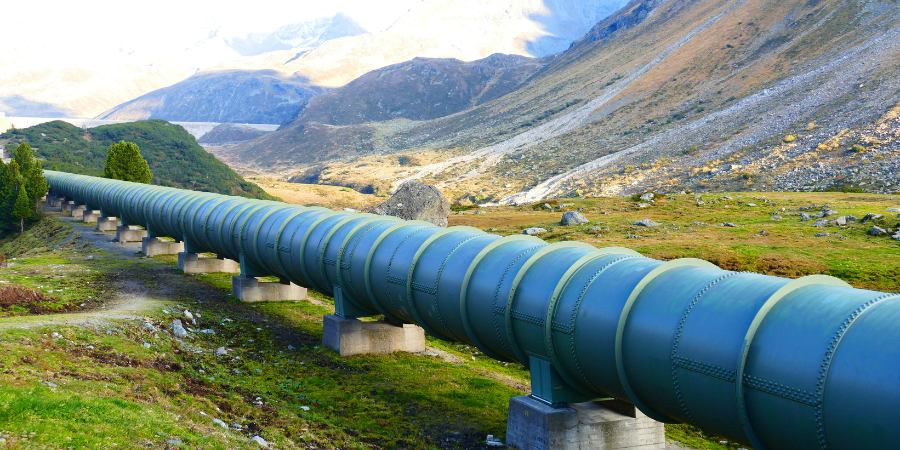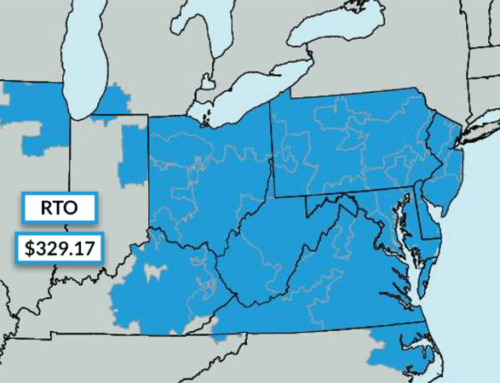Natural gas is an important energy source for commercial and industrial businesses used for heating, industrial applications, and on-site electricity generation. In the current energy economy, natural gas prices have been quite volatile, significantly impacting energy costs for these organizations. Finding strategies for reducing natural gas expenses is a primary initiative for businesses and large corporations alike. This article aims to outline the factors that contribute to high gas prices, the various ways gas is used in commercial applications, and how businesses can strategically pay less for natural gas through strategic cost-saving measures.
How Natural Gas Prices Are Determined
Retail natural gas prices are determined by a variety of factors. First, let’s analyze the components of a retail natural gas rate and the factors that influence these costs. The chart below shows a representative model of a retail gas rate, otherwise known as a burner tip rate.
| Cost Component | Rate ($/Dth) | Total Cost ($) |
|---|---|---|
| Commodity | $3.50 | $35,000 |
| Interstate Pipeline Fees | $0.50 | $5,000 |
| Intrastate Pipeline Fees | $0.30 | $3,000 |
| Local Distribution | $1.00 | $10,000 |
| Fuel Loss | $0.10 | $1,000 |
| Regulatory Fees | $0.20 | $2,000 |
| Total Cost | $5/60/Dth | $56,000 |
Natural Gas Commodity
The primary cost component of a retail natural gas rate is the physical cost of the gas commodity. Natural gas is drilled or fracked at production sites, sent to facilities for processing, and then fed into the interstate pipeline network. The primary driver of natural gas prices is supply and demand. When supply for natural gas is high, represented by an excess amount of natural gas storage, prices typically trend lower. On the other hand, when demand for natural gas is high due to heating in Winter, economic growth, or electricity generation, prices tend to trend upward.
Interstate Natural Gas Transport
Interstate pipeline tariffs are fees charged by federally regulated pipelines that transport natural gas across state lines. These pipelines are overseen by the Federal Energy Regulatory Commission (FERC), which regulates pricing and access to ensure fair market competition.
Key Components of Interstate Pipeline Tariffs:
- Reservation Fee: This is a fee charged by pipeline operators to ‘reserve’ capacity on a particular pipeline. Natural gas companies are required to pay this fee in order to send a set amount of gas through a pipeline at any given time. It is typically billed in $/Dth per day. Shippers pay a fixed reservation charge based on the maximum daily quantity (MDQ) of natural gas they reserve, whether they use the full amount or not.
- Commodity Fee: Natural gas pipeline commodity fees are charges applied to shippers based on the actual volume of natural gas transported through a pipeline. These fees are separate from reservation fees, which secure firm transportation capacity, and are typically assessed as a variable cost per dekatherm (Dth) or million British thermal units (MMBtu) moved.
- Fuel Retention Charges: A small percentage of transported gas is retained by the pipeline operator to cover fuel usage for compression, leakage, and line losses.
- Rate Zones & Distance-Based Costs: Many interstate pipelines operate with rate zones, meaning costs increase based on the distance the gas travels. If the gas must be moved across multiple zones, businesses could see higher transportation costs.
Intrastate Natural Gas Transport
Intrastate pipelines transport natural gas within a single state, typically moving gas from interstate pipelines to local distribution companies (LDCs) or large industrial end-users. Unlike interstate pipelines, intrastate pipelines are regulated at the state level, often by the state’s Public Utility Commission (PUC).
Key Components of Intrastate Pipeline Fees:
- Intrastate Transmission Fees: These are fixed and variable charges for transporting gas within a state’s pipeline network.
- Citygate Delivery Charges: Some intrastate pipelines deliver gas directly to citygate points, where the gas enters the local distribution network before reaching customers.
- Local Access Fees: If an industrial customer is directly connected to an intrastate pipeline (bypassing LDCs), they may pay an access fee instead of standard distribution tariffs.
When demand for natural gas differs from one location on the pipeline to another, pipeline fees to transport gas to the higher demand area increase. On the flip side, when demand in the shipped-to area is low, transportation costs decrease.
Distribution, Fuel Loss, and Regulatory Fees
These are additional costs tacked on to the retail natural gas price that are not market-based rates. These fees are either set by local utility tariffs, regulators, or account for fuel loss when gas is being transported. These fees typically account for a smaller percentage of the total gas price and are often regarded as the cost of doing business by natural gas suppliers and consumers. Some creative ways to offset these costs including using less natural gas, switching to alternative fueling sources during high-demand periods, or participating in natural gas demand response programs.
How Businesses Can Reduce Costs for Natural Gas
There are several ways for commercial and industrial companies to offset or reduce natural gas costs. Let’s explore some of the top strategies in more detail.
1. Shop For A Better Energy Contract
Comparing energy plans from multiple suppliers to find competitive rates is a great way to shop for natural gas for your business. It’s important to understand the energy contract language, hidden fees, and price pass-through clauses that might affect your total price for gas. Choosing to work with a commercial energy broker can be a beneficial decision as the broker can help you navigate the complex world of natural gas deregulation.
2. Lock In Low Rates When Market Prices Are Favorable
Track natural gas prices and secure fixed-price contracts when rates are low. This can give you a competitive advantage in the market, especially when prices rise after you’ve secured a low futures contract. It’s important, however, to weigh the pros and cons of fixing vs. floating your energy rates. Working with a market expert can be a good first step towards understanding these differences.
3. Reduce Natural Gas Consumption Through Energy Efficiency
Upgrading heating systems, boilers, and insulation helps to minimize gas waste. In addition, implementing business energy-saving tips such as optimizing thermostat settings and performing regular maintenance can help your equipment run more efficiently, reducing energy usage.
4. Leverage Demand Response Programs
Participating in natural gas demand response programs can help you earn incentives for reducing peak-hour consumption. You can achieve this by adjusting production schedules to avoid using gas during peak pricing periods. In turn, this can also help to offset high natural gas supply costs if you purchase natural gas on the index market.
5. Utilize Renewable Energy and Hybrid Systems
Exploring renewable energy alternatives, such as renewable natural gas (RNG), can help to promote decarbonization. Considering hybrid systems that integrate natural gas and renewable energy helps to maximize efficiency. For example, an on-site natural gas generator can help offset electrical usage during high usage periods. The electricity can then be stored by a battery energy storage system (BESS) for consumption at later periods.
6. Conduct a Utility Bill Audit
Utility audits help to identify billing errors, overcharges, or discrepancies that could inflate costs. In regulated and deregulated energy states, there are various tariff schedules offered by utilities for natural gas delivery charges. These schedules often include firm and interruptible service. A billing expert can evaluate your gas usage and determine if switching to a less expensive tariff is in your business’s best interest.
7. Consider Natural Gas Storage & Hedging Strategies
Large businesses with high gas consumption can utilize storage options to buy gas at lower rates and use it when prices rise. While this strategy is typically only implemented by very large gas consumers, wholesale trading companies can act as a conduit for these types of transactions. Furthermore, natural gas hedging strategies can help businesses lock in stable pricing for future consumption.
8. Monitor & Manage Energy Usage
Use real-time analytics and smart energy management tools to track gas consumption. These tools include building automation systems and sensors that can track usage at the equipment asset level. This type of data insight allows you to calculate business energy consumption and make educated decisions regarding your operations to help curtail energy usage.
Need Help Developing A Natural Gas Strategy?
Natural gas costs represent a significant portion of most business’s energy bills. It’s important to understand how gas rates are calculated and the various cost-savings strategies to implement. Working with a natural gas market expert like Diversegy can help you understand these markets and make better decisions. Contact our team of experts today to learn more.



